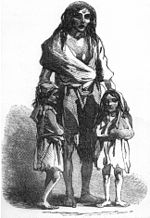Portal:Ireland/Selected article archive/33
The Great Hunger (Irish: An Gorta Mór or An Drochshaol, litt: The Bad life) is a highly contentious period of history between 1845 and 1852 during which the population of Ireland was reduced by 20 to 25 percent. It is known by various names, such as The Great Famine in Ireland itself and The Irish Potato Famine internationally. The proximate cause of the famine was a pathogenic water mould, Phytophthora infestans, the disease it causes is commonly known as late blight of potato. Though P. infestans ravaged potato crops throughout Europe during the 1840s, its human cost in Ireland was exacerbated by a host of political, social, economic, and climatological factors which remain the subjects of heated historical debate.
The famine was a watershed in the history of Ireland. Its effects extended well beyond its immediate demographic impact and permanently changed the island's political and cultural landscape. For both the native Irish and those in the resulting diaspora, the famine entered folk memory and became a rallying point for various nationalist movements. Virtually all modern historians of Ireland regard it as a dividing line in the Irish historical narrative, referring to the preceding period of Irish history as "pre-Famine." Read more...

